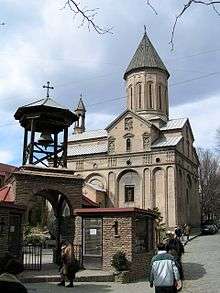Norashen Church, Tbilisi
| Norashen Surb Astvatsatsin Church Նորաշեն Սուրբ Աստվածածին եկեղեցի | |
|---|---|
 Norashen Church, March 2007 | |
| Basic information | |
| Location |
Leselidze Street, Old Tbilisi, Georgia |
| Affiliation | Armenian Apostolic Church |
| Architectural description | |
| Architectural style | Armenian |
| Completed | 1467 |
Norashen Holy Mother of God Church or Norashen Surb Astvatsatsin Church (Georgian: ნორაშენი, Armenian: Նորաշեն Սուրբ Աստվածածին եկեղեցի ; Norashen meaning "newly constructed" in Armenian) is a 15th-century Armenian church located in Old Tbilisi, Georgia. It was founded in 1467 and renovated in 1650. It also underwent renovations later in 1795, 1808, and 1875.
Architecture
The church of Norashen is cruciform in plan with a single dodecagonal drum above, and twelve long windows located under a conical umbrella style dome. A small cupola sits at the peak of a gable on the roof. It has six slender columns that hold up a decorative arched hexagonal drum and small conical dome.
Public Controversy
Recently the church has been the subject of dispute between Armenians and the Georgian Orthodox Church which has sought to convert it into a Georgian Church. Among the actions taken by the Georgian church is the enclosing of the church with a concrete fence, the defacing of Armenian inscriptions on tombstones, and the bringing in of Georgian tombstones.[1]
Georgian appropriation
It was claimed that beginning in 1983, Georgian authorities began the systematic removal of Armenian characteristics from the church. Among the changes were:[2]
- The destruction of the portal (in front of the northern door) in 1983
- The removal and disappearance of Armenian tombstones in 1983
- The development of a construction site only a few meters south from the church in 1995
- The removal and disappearance in 1995 from the high altar of the 17th century khachkar (cross stone) with an inscription
- The destruction of the Armenian baptistry situated in the internal northern wall in 1995
- The closing of the church doors while in the process of destruction and alteration works progressed in 1995
- The replacement of the old doors with doors decorated with a "Georgian cross"
- The removal and destruction in 1995 of another khachkar from 1650 that was set in the wall inside the church
- The covering with asphalt of a tombstone situated near the northern entrance of the church
Gallery
%2C_Tbilisi%2C_Georgia.jpg) Closeup of the church
Closeup of the church Norashen Church (leftmost) among other churches in the Old Quarter of Tbilisi
Norashen Church (leftmost) among other churches in the Old Quarter of Tbilisi View from surrounding streets
View from surrounding streets.jpg) Norashen
Norashen- View of Old Tbilisi from the fortress (Norashen in center-right)
- Khachkar in Norashen Church
- An Armenian inscription on the Norashen Church
See also
References
- ↑ Ghazinyan, Aris. "Crisis of Faith: Armenian identity threatened in Tbilisi". ArmeniaNow. Retrieved 6 July 2009.
- ↑ Karapetyan, Samvel (1998), The State Policy of Georgia and the Monuments of Armenian Culture (1988-1998) (in Armenian) (1st ed.), Yerevan: Research on Armenian Architecture, pp. VI–VII, ISBN 5-8080-0144-7
Bibliography
- Kristine Aghalaryan (8 December 2008). "An Historical Overview of the Norashen Sourb Astvatzatzin Church". Hetq. Retrieved 8 July 2009.
- Karapetyan, Samvel (1998), The State Policy of Georgia and the Monuments of Armenian Culture (1988-1998) (in Armenian) (1st ed.), Yerevan: Research on Armenian Architecture, pp. VI–VII, ISBN 5-8080-0144-7 (before-and-after photographic documentation, newspaper articles)
External links
| Wikimedia Commons has media related to Norashen Church, Tbilisi. |
- A Flickr photo set of Norashen (summer 2008)
- 3D model of the Norashen Church
- Photos of Norashen being "Georganized"


